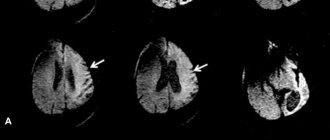Healthy sleep is one of the main factors in a person’s well-being. It is not always possible to get enough sleep or sleep the required 8 hours every day. Of course, there are also stresses, failures at work, and the brain scrolls through depressing thoughts half the night. But what to do when you manage to fall asleep without problems, but are tormented by nightmares or such a phenomenon as sleep paralysis? In this state, you cannot move, you cannot shout, or say anything, and all this is accompanied by seemingly mystical visions. This is really alarming and frightening for any person, especially a child who has encountered such burning in his life for the first time. In this article we will talk about sleep paralysis (awakening cataclepsy), how terrible it is, and how it affects the general condition of a person.
Awakening cataclepsy can occur not only for physiological, but also for psychological reasons
What is sleep paralysis
First you need to understand what sleep paralysis actually is. Sleep paralysis is a condition in which temporary stupor appears while the brain is already in the active phase and the body is completely or partially paralyzed. This condition appears during falling asleep (the moment of falling asleep) or awakening. Sleep paralysis is also called sleep stupor or awakening cataplexy.
Such conditions are studied by the branch of medicine – somnology. Somnologists generally believe that sleep paralysis occurs when dreaming and waking occur. Sleep paralysis usually occurs upon awakening (coming out of the sleep phase), when the dreaming stage ends, or before falling asleep. However, cases of sleep paralysis before falling asleep are much less common. The dreaming stage is called the REM stage of sleep, during which all a person’s muscles completely relax, and in sleep paralysis, this relaxation is maintained while the brain is active.
There are currently no accurate statistics on sleep paralysis. This may mean that actual cases of paralysis are much higher than the officially reported 5-8%. If you ask your friends if they have ever dreamed of sleep paralysis, explaining its symptoms, you will probably meet a couple of acquaintances who have experienced this phenomenon.
What does it look like
For understanding, I will give an example: a person realizes that he has woken up, his thoughts and consciousness are clear, however, if he wants to turn over, the body does not obey, and the muscles seem to be paralyzed. The person lies motionless, unable to speak or call for help. Moreover, often with sleep paralysis, a person begins to notice dark figures that stand next to the bed or sit nearby, sometimes it feels as if they are sitting right on the chest. At the same time, the heart begins to beat quickly, the person may choke and hear strange sounds and buzzing. Directly in this state, when you wake up, you experience anxiety or an attack of anxiety (fear, rapid heartbeat, anticipation or feeling of something bad, etc.). This state lasts from 10 seconds to 2 minutes, after which the ability to move again appears, the heart rate is restored and the condition returns to normal.
Many people confuse what they see during sleep paralysis with mysticism and paranormal phenomena.
What causes sleep paralysis
In most cases, sleep paralysis occurs when a person is lying on their back while sleeping. The state of sleep paralysis is provoked in all people by various pathologies and conditions of the nervous system, as well as a number of other reasons. The causes of sleep paralysis include severe stress, stimulation of the nervous system, disruption of the biological clock, mental disorders, and others. Experts include factors that provoke sleep paralysis:
Depressive conditions of any nature and severity
Arterial hypertension, hypertension (high blood pressure)
Increased physical activity
Post-traumatic stress disorder
Neurodegenerative diseases (Parkinson's disease, Alzheimer's disease, dementia and the like)
Diseases of the nervous system (narcolepsy or other disorders associated with sleep pathology)
Migraine, frequent headaches, epilepsy
Use of pharmacological drugs, toxic effects on the nervous system (substance abuse, drug or alcohol addiction, taking tranquilizers or antidepressants)
Emotional or physical overload when the brain does not rest
Somnambulism (sleep disorders in which a person performs certain actions while asleep)
Anxiety and anxiety disorders
Mental illnesses, disorders. These include bipolar disorders, schizophrenia and other diseases that are characterized by sleep disorders, nervous system disorders, and neuronal oscillations.
Fears, traumas, which are also accompanied by nightmares
Is sleep paralysis dangerous?
Sleep paralysis has been known to mankind since ancient times; it is also called old witch syndrome. Its appearance was associated with the action of black magic, evil spirits, demons and other evil spirits. About 40% of people have experienced it at least once. And in most cases it does not affect the general health of a person.
That is why it does not pose any particular danger to humans, although anxiety and emotional shock after what they saw can affect the human psyche.
A person’s fragile psyche can lead to the fact that upon waking up, a person is convinced to experience a paranormal presence
Causes of sleep paralysis
Sleeping position . If you frequently sleep on your back (lying on your back), you may be at increased risk. It is not known why sleeping on your back increases the likelihood of sleep paralysis, but more than 50% of cases of sleep paralysis occur in this position.
Brain waves . During episodes of sleep paralysis, there is a disproportionate amount of alpha waves with intermittent bursts of beta waves, especially in cases where people have reported visual hallucinations.
Medicines . The use of various medications, whether pharmaceutical, over-the-counter, or illegal, can theoretically contribute to the development of sleep paralysis. Even alcohol is considered a potential trigger as it can disrupt various stages of sleep.
Impaired neurotransmission . Impaired levels of neurotransmitters are thought to increase a person's susceptibility to sleep paralysis. In particular, GABA (an inhibitory neurotransmitter) and glycine may be the cause.
Mental illnesses . Those who suffer from mental illnesses such as anxiety disorders, bipolar disorder, depression or schizophrenia may be more prone to sleep paralysis. These conditions are characterized by sleep disturbances, neurotransmitter fluctuations, and are often treated with strong psychiatric medications, which can easily increase the likelihood of this phenomenon. []
Chaotic sleep schedule, sleep disorders and deprivation . If you work shifts or don't have strict bedtimes and wake-up times, you may be at increased risk of sleep paralysis. This disrupts the circadian rhythm and sleep cycle. Leads to changes in the concentration of neurotransmitters, brain wave activity, regional blood flow, etc. All of these changes increase risk.
Other reasons:
- Genetic predisposition.
- Leg cramps.
- Neurological disorders (migraine and epilepsy).
- Neurodegenerative diseases (dementia, Alzheimer's, Parkinson's).
- Stress.
- Mental trauma.
What happens with sleep paralysis
As previously mentioned, sleep paralysis occurs before falling asleep or upon awakening. What happens with sleep paralysis?
Doctors explain the occurrence of paralysis as follows: in the REM sleep phase, the human body falls into numbness and becomes paralyzed. At this moment, consciousness, visual organs and organs whose work is necessary to maintain life remain active. In this state, the body is completely relaxed and ready for further rest and unloading of brain activity.
The state of sleep paralysis appears when there is a failure in the activity of brain mediators, which do not give a signal in time to turn on the muscles. This results in a temporary stupor, which explains the delay in the functioning of the muscles and brain. A person consciously feels that he has woken up, but the body and muscles at this moment do not yet obey him - the dream is mixed with reality.
People who have experienced paralysis have similar descriptions of what happened. Silhouettes, faces, distorted human bodies, hands, and distortion of reality may appear. At the same time, such visions are felt as absolutely real. Sometimes such sleep paralysis is accompanied by special sound deformations - clapping, steps, jumping and other temporary sounds that frighten the person waking up.
How to induce sleep paralysis?
Despite the fact that most people are afraid of night stupor, there are individuals who want to know how to get into sleep paralysis. Often these are those who are interested in esotericism, astral travel, etc. Such individuals can follow one of the following tips:
- To induce stupor when falling asleep, you need to lie on your back without a pillow and monitor your sensations. If the sounds change, the body “paralyzes,” which means the desired state has been achieved.
- The next technique is to reproduce the feeling of flying before going to bed - on a swing, in zero gravity. When the desired sensations are achieved, a sleepy stupor will occur.
- The last way is with coffee. In a state of extreme fatigue, you need to drink strong coffee and go to bed. The body will begin to fall asleep, and if the coffee acts at the right moment and prevents the mind from falling asleep, the necessary phenomenon will arise.
The Scientific Explanation of Sleep Paralysis
Thanks to scientific research, it has been noted that paralytic sleep can occur in more than 30% of a completely healthy population who do not have mental disorders. The first cases of paralysis occur on average in people aged 16–17 years. Women are slightly more likely to experience sleep paralysis - 19%, and less often among men - 15%. It is important to understand that such phenomena also occur in young children, but most often parents reduce what the child describes to childish impressionability and fantasy.
The mechanism of occurrence from a scientific point of view is explained by many scientific theories, which we will consider with you further.
- The first theory is based on heredity. In the process of mutation of the gene that is responsible for circadian rhythms (fluctuations in the biological processes of the human body associated with the transitions of day and night), changes occur in the advanced phase of sleep.
- Clusters of cells. Mediators located in the brain area accumulate in groups without forming a single center. Thus, some mediators work separately, which leads to disruption of the muscles and consciousness.
- Activation of brain neurons. This theory is based on the fact that nonspecific activation of neurons occurs in the brain, forming two centers that are responsible for the phases of sleep. Such nerve centers are located in the diencephalon and ensure the functioning of neurons with a significant delay from each other.
The peculiarity of the appearance of sleep paralysis while sleeping on the back is explained by scientists by the fact that in this position the blood drains from the frontal lobes of the brain - the person becomes prone to hallucinations. Oxygen starvation also provokes the occurrence of this condition. Hypoxia entails disruptions in blood circulation, respiratory processes, and the appearance of convulsive conditions.
People who have experienced sleep paralysis note that it most often occurs on the back
What is it and how does it manifest itself?
The phenomenon can occur in both men and women of different ages, but statistics say that the majority who experience sleep paralysis are teenagers and young adults aged 12 to 25 years .
This happens because the lifestyle of the younger generation is often not conducive to healthy sleep.
The manifestation of SP is sudden: a person wakes up and realizes that he cannot move his limbs.
The following symptoms often occur:
- visual and auditory hallucinations;
- fear, horror, panic;
- shortness of breath, increased heart rate;
- feeling of suffocation;
- feeling of someone else's presence;
- violation of orientation in space and time;
- fear of death (a person may even feel as if he is dying).
Sometimes this state is preceded by the following sensations:
- tinnitus;
- hypersensitivity to sound;
- partial or full body awareness.
The symptoms are the same for both men and women and occur to the same extent.
Symptoms of sleep paralysis
The symptoms of sleep paralysis are different for everyone who experiences the condition. Experts divide the symptoms and signs of night paralysis into primary and secondary.
Primary symptoms include the following:
- Inability to move. Paralysis affects all major muscle groups and the person is unable to move.
- Inability to utter any words or even move your lips.
- Semi-conscious or conscious state. That is, during sleep paralysis, a person remains conscious and is able to remember the entire episode. Or, in the case of a semi-conscious state, he is partially aware of the reality of what is happening.
- Perception of the external world. Thus, a person in night paralysis fully perceives his environment, things, colors, materials, and so on.
Experts include secondary symptoms:
- Heavy, labored breathing. Difficulty breathing can be caused by the very position in which a person fell asleep, panic attacks, pressure in the chest/on the chest.
- Pressure in or on the chest. This symptom is associated with difficulty breathing. A person feels pressure on the chest, similar to a pile of something on top. Many people describe this condition as “like someone sitting on their chest.”
- Feeling of uncontrollable fear. An incomprehensible state, the inability to speak and move can cause anxiety and panic, which are accompanied by the body's natural reaction - fear.
- Feeling helpless. Most of those who have experienced sleep paralysis note that during the period of paralysis they experienced absolute helplessness. It is also associated with uncontrollable panic, fear and cessation of motor functions.
- Hallucinations. All cases of sleep paralysis are accompanied by various kinds of hallucinations. These hallucinations can affect the auditory, visual, and tactile senses. For example, with auditory hallucinations a person hears buzzing, crackling, rustling, and voices. With visual ones, they see objects, creatures, people that do not exist in reality. Some experience olfactory hallucinations of various kinds, often in the form of smells.
- Mystical and unusual sensations. Mysticism is explained by the fact that consciousness is confused with dreams; the human psyche “draws” images that usually correspond to the disorders and fears that a person experiences, for example, when under prolonged stress. Some cases are accompanied by sensations of mystical creatures, a feeling that a person is swimming or flying, soaring.
Symptoms of sleep paralysis are the same for all survivors
Diagnosis of sleep paralysis
Isolated sleep paralysis (ISP) : If you have ever consciously noticed an inability to move or speak while sleeping or upon awakening, then you have experienced isolated sleep paralysis. This is a common occurrence and usually not a problem. Episodes usually last only a minute or two and are unlikely to continue.
Recurrent isolated sleep paralysis (RISP) . If you constantly notice an inability to move or speak when falling asleep or waking up, you have recurrent isolated sleep paralysis. This is a chronic condition that can trigger anxiety and lead to a fear of falling asleep. Only 3% of all people with sleep paralysis have recurrent episodes, and many of these have an underlying condition such as narcolepsy.
Types of sleep paralysis
During research into the phenomenon of sleep paralysis, scientists identified two main types, which we will consider later.
- The first type is semi-conscious (hypnagogic). Semi-conscious cases are those that occur when a person begins to fall asleep. An attack of paralysis begins at the junction of wakefulness and sleep.
- Hypnopompic. This type of sleep paralysis occurs upon awakening. A person wakes up, or rather those areas of the brain responsible for active activity, but consciousness itself has not yet returned to normal after the sleep phase. This condition occurs from a sudden awakening, such as noise.
The dangers of sleep paralysis
Many, understanding what sleep paralysis is, strive to understand why such a condition is dangerous. Experts unanimously agree that this phenomenon is not life-threatening and is a natural reaction of the human body to certain influences of external factors. Pathological malaise usually lasts several minutes. After breathing and heartbeat stabilize, internal fear disappears.
The main danger is memories of a momentary nightmare that you experienced. Because of this, a person begins to be afraid to fall asleep. Stupor, in this case, provokes sleep disorders and serious neurotic disorders that require treatment. In other words, a natural phenomenon poses a threat to health only with frequent attacks.
It is also dangerous if a person who has experienced stupor becomes fixated on it. The belief that incomprehensible attacks are symptoms of the development of a serious pathology that threatens life leads to neuroses. Mental problems can arise in people who associate a natural phenomenon with otherworldly forces.
Hallucinations during sleep paralysis
During research conducted in 1999, scientists identified three main types of hallucinations that occur during sleep paralysis: presence, incubus and vestibular-motor hallucinations.
Feeling of presence
This type of hallucination is expressed in sensations of the presence of people, creatures, animals. And also in auditory and visual hallucinations, which can be expressed in the sensation of whispers, steps, door slams, noise or voices and other various phenomena of a hallucinogenic nature.
Hallucinations of a sense of presence are born in the brain center - the amygdala, also called the “fear center”. The active activity of the amygdala is triggered by external stimuli, to which the fear center immediately sends a reaction in the form of fear to protect the body.
The entire amygdala complex in the brain structure includes the amygdala itself, the thalamus, which triggers the activity of the amygdala, the anterior cingulate cortex and intermediate links. Scientists have determined that when projections from the thalamus affect the fear center, the cerebral cortex and its other parts begin to activate a protective function, which causes obsessive hallucinations.
In situations with a real threat, areas of the brain begin to actively develop defensive reactions. Brain activity analyzes the external threat and, if it is not confirmed, the impulses weaken and the activity of the fear center decreases. With sleep paralysis, the analysis of brain activity reaches a dead end and is unable to find a threat. Thus, the fear center does not turn off, and the person experiences overwhelming fear, panic and anxiety during sleep paralysis.
The feeling of presence is the most terrible sensation during sleep paralysis
Incubus
The next type of hallucination has a mysterious name - incubus. In the Middle Ages, an incubus was a name given to a demon-tempter who appeared to young and innocent girls in search of debauchery. Many who have experienced sleep paralysis say they have seen a witch, devil or other demonic creatures sitting on their chest. This is what explains the pressure on the chest and the inability to breathe freely.
During the sleep phase, breathing accelerates and becomes more shallow in some areas. Sleep paralysis occurs precisely at a time when breathing remains shallow, blocking its further passage. When muscles are paralyzed, it is not possible to slow down accelerated breathing - muscular and respiratory resistance arises, which is felt as pressure on the chest.
Thus, stationary muscles send a signal to the brain centers responsible for reactions associated with struggle and survival functions. It is these centers that cause spasms and pain. A person feels that he really feels them, although the body itself remains fine and this is nothing more than a protective reaction of the brain.
With paralysis, you can not only see the entire creature or object, but also parts of the body, such as your hands. It may also seem to you that someone is breaking down a door or a wall - it all depends on the circumstances and the person’s very consciousness.
Vestibular-motor hallucinations
Hallucinations associated with vestibular-motor functions cause a person to experience flying, falling, floating or rising, in some cases floating above the bed. The vestibular system is located in the temporal, frontal and parietal lobes - it is responsible for coordinating all human movements and is close to the centers regulating circadian rhythms in the brain stem. When the vestibular system engages the brain stem, a person experiences movement, floating, and other unusual changes in motor activity.
The nature of the movements depends on which lobe is involved during sleep paralysis:
- The angular gyrus allows for the sensation of floating or the sensation of floating;
- The parietal lobe causes sensations of falling, sliding, or rising.
Another reason for changes in vestibular-motor functions is a weakening or decrease in blood flow to the brain and other lobes - as a result, disturbances in motor and tactile function occur and vestibular-motor hallucinations appear.
Sleep paralysis may cause sensations of levitation.
Sleep paralysis: causes, symptoms and treatment
All information is provided for informational purposes only and does not constitute medical advice. The system, methods, methods of treatment, necessary medications can only be prescribed by your attending physician.
Sleep paralysis is a condition that occurs at the onset of sleep or upon awakening, when all of a person's senses and awareness are intact, but they are unable to move.
It is often accompanied by complex hallucinations and intense fear.
This terrible phenomenon is described in all cultures. In Mexico it is known as "dead body climbing on me", in Japan it is called "Kanashibari", and in Newfoundland it is called "old hag".
Although the condition is not life-threatening, episodes of sleep paralysis can be a scary and traumatic experience.
Quick Facts
- Most often occurs in adolescence.
- Episodes are short, lasting from a few seconds to several minutes.
- Recurrent episodes are associated with narcolepsy.
- Predisposing factors include excessive stress, jet lag due to long-distance flights, loss of sleep and panic disorders.
- Quite a common problem in the world; the estimated prevalence is 5-40%.
- This condition is usually accompanied by hallucinations.
- Inability to move and speak is a major feature.
- May be associated with panic disorder.
- Has no physical harm.
- It can be prevented.
What is sleep paralysis?
This is a parasomnia, or an unwanted event that occurs along with sleep. It is known to occur immediately after falling asleep or upon waking up in the morning.
Episodes of sleep paralysis can be divided into three categories: intruder, incubus, and vestibular-motor category.
Episodes of sleep paralysis are often accompanied by hypnagogic (visual, auditory and sensory) hallucinations that occur during the transition between sleep and wakefulness, which are divided into three categories:
- Intruder (intruder): sounds of door handles opening, shuffling of feet, human shadow, humanoid, alien, sense of threat in the room.
- Incubus (evil spirit): feeling of pressure on the chest, difficulty breathing with a feeling of suffocation, sexual assault by an evil entity. A man believes that he is about to die.
- Vestibular-motor category: spinning, falling, swimming, flying, hovering above one's body, or other sensations of being outside one's body.
The experience has been recorded for centuries, with eerie similarities between different cultures.
Henry Fuseli's famous painting "Nightmare" depicts a woman sleeping on her back and a demon sitting on her chest. The painting, painted in the 18th century, displays classical features.
Although it does not last long and is not life-threatening, most people who experience the condition remember it as intrusive and frightening.
What causes?
During normal sleep, your body is relaxed and your conscious muscles do not move; this prevents self-harm from activities in sleep.
During sleep paralysis, the body's transition into or out of REM sleep is synchronized by the brain, much like hiccups. The human consciousness is awake, but the body remains in a paralyzed state of sleep.
During an episode, the areas of the brain that are responsible for detecting danger are in a state of heightened activity and are overly sensitive.
Every day, non-threatening sounds, sensations and other stimuli are simply ignored by the brain during the normal sleep-wake cycle, whereas during sleep paralysis they can become intense nightmares.
Additionally, disruption or separation of REM sleep has been correlated with sleep paralysis.
It can be a symptom of medical problems such as narcolepsy, clinical depression, migraines, obstructive sleep apnea, hypertension and anxiety disorders. If the disease develops in healthy people in the absence of narcolepsy, it is called isolated sleep paralysis.
Not being able to move or speak can be very frightening during sleep paralysis, especially if you are fully conscious.
- Inability to move while falling asleep or immediately after waking up; duration – several seconds or minutes.
- Wakefulness.
- Unable to speak.
- The presence of hallucinations and sensations of a frightening nature. Descriptions include humanoids, a human shadow, a demon, or other creatures with murderous intent.
- Feelings of pressure on the chest, the bed moving, doors opening, or shuffling steps.
- Despite clearly remembering the details of sleep paralysis, the person is not sure what was reality and what was a dream.
- Feeling of difficulty breathing.
- Feelings of approaching death.
- Sweating.
- Headaches, muscle pain and paranoia.
Tests and diagnostics
It is not a medical diagnosis, but is classified as a parasomnia.
Determining whether sleep paralysis is present is based on the person's medical history and description of the event. The doctor then evaluates whether further testing is necessary to explore the possibility of predisposing causes.
Treatment and prevention
It is more likely to occur in conditions of unmanageable stress and irregular or inconsistent sleep patterns. Therefore, managing stress and maintaining a regular sleep schedule can reduce the likelihood of sleep paralysis.
Tips for better sleep:
- The onset of sleep and awakening should be the same even on holidays or weekends.
- Improve your sleep environment. The mattress, bed linen and pajamas should be comfortable. Keep your bedroom clean, dark and cool.
- Reduce lighting in the evening, use night lights to go to the toilet at night.
- Get good exposure to daylight while you're awake.
- Use the bed only for sleeping and sex.
- Avoid naps after 3 pm and limit them to 90 minutes.
- Don't eat much in the evening or eat 2 hours before bed.
- Don't sleep with the lights or TV on.
- In the evening, avoid drinking alcohol or caffeinated products.
- Do exercises daily, but no later than 2 hours before bedtime.
- Practice calming activities before bed, such as reading or listening to relaxing music.
- Avoid watching electronics for at least an hour before bed.
Additional activities that may help prevent sleep paralysis include:
- Management of depressive and anxiety disorders.
- Reduce stimulant intake.
- Regular meditation or prayer.
- Don't go back to sleep again.
- No need to nap between 8 and 10 am.
People who experience an episode of sleep paralysis need to be sure that they are not under spiritual attack and that they are not going crazy. It is important to tell a close friend or doctor about this incident.
Understanding the physiology of sleep and the mechanisms of sleep paralysis is an important step towards overcoming it.
Ongoing stress and sleep cycle disruptions can have serious health consequences. Maintaining good sleep habits is important not only for managing sleep paralysis, but also for overall health and well-being.
Material prepared by: Anesthesiologist-resuscitator Andrey Anatolyevich Dotsenko
Last change: 2020-08-1 Date of writing: 2015-06-12
Is it possible to die during sleep paralysis?
Sleep paralysis has not been fully studied, and the nature of paralysis is still not clear to either scientists or other physicians. It is unknown whether sleep paralysis is a pathology or a minor deviation from the norm. However, psychologists recommend treating isolated cases as ordinary nightmares or a form of sleepwalking (somnambulism).
A large number of studies have not revealed a single case of death specifically due to sleep paralysis or during it, although if you experience such sensations too often, it makes sense to consult a neurologist and epileptologist.
A person is indeed capable of dying in his sleep, but, as a rule, this happens from a heart attack, stroke or other causes and disorders that lead to cardiac arrest. You also don’t have to worry about breathing problems, because when the level of oxygen in the blood drops, a person immediately wakes up.
Cases of death during sleep do occur, for example, with apnea syndrome, when breathing stops, however, death itself does not occur as a result of stopping breathing, but as a result of its effect on the cardiovascular system. Therefore, scientists answer the question “Is it possible to die during sleep paralysis” unequivocally no.
Sleep paralysis - interesting facts
Disputes on the topic of sleep paralysis - is it a disease or a mystical phenomenon periodically begin and die out, without reaching a common opinion. Most people will be much more interested in learning various facts about this condition:
- The more often a person experiences paralysis, the more intense it is. Scientists believe that many religious miracles, mystical phenomena, and alien abductions are actually just visions against the background of this state.
- The syndrome was first described in the 10th century by a Persian physician. A doctor from the Netherlands had a chance to see a patient in a state of stupor in the 17th century. He had to calm the patient down, convincing her that it was a nightmare.
- The artist Heinrich Fussli embodied his idea of sleep paralysis in the painting “Nightmare,” which depicts a woman with a demon sitting on her chest.
- One of the most frightening nightmares of the syndrome is the feeling of being in a dead body. Therefore, among various peoples, sleep paralysis has names that include words associated with death.
- Old witch syndrome is the opposite of somnambulism.
How to help yourself during an attack
The duration of sleep paralysis lasts several seconds or minutes. During this time, nothing terrible happens to the person, but the condition is not the most pleasant. In night paralysis, a person can become aware of what has happened to him if, for example, he is informed about the possibility of such a state or has already experienced it before. Unpleasant and even terrible sensations during paralysis do not please anyone and do not give much pleasure, therefore, to get out of this state on your own, you can take some actions:
- Realize that this state and everything that happens is just the influence of hallucinations. The resulting condition does not occur in reality, but is just a slight disruption of brain activity.
- Try to relax, relax all your muscles. Fear forces a person to tense the whole body more, which only worsens the convulsive and constrictive state.
- Try moving your muscles, such as moving your tongue, moving your lips, blinking, rolling your eyes, or using your fingers and toes.
- If the muscles still do not obey you, distract yourself from what is happening with brain activity in the form of counting, pronouncing words, letters, concepts or other systemic formations.
When recovering from sleep paralysis, it is important to try to gain some ability to move the body.
Symptoms of sleep paralysis
In some patients, sleep paralysis occurs only once in a lifetime, while in others it occurs periodically with all possible frequency, up to several times in one night.
Being in this state, a person realizes that he cannot move, and this causes horror and panic in him. In addition, visual and auditory hallucinations are observed: the patient thinks that there are demons, ghosts or alien creatures next to him, threatening voices, creeping steps, squeaking, noise and pulsating sounds are heard.
In addition, a person feels a feeling of pressure on the chest, stomach and throat - it seems to him that some kind of monster is sitting on him and strangling him. Some patients feel that they are turning from a supine position to their side, but at the same time they realize that they are lying motionless.
The patient's breathing is difficult, the heartbeat and pulse are increased, the body twitches slightly, and a grimace of horror and tension freezes on the face.
Probably, many suffering from this disorder will be reassured by the fact that during sleep paralysis nothing terrible can happen to them - you cannot die or go crazy, and the feeling of suffocation will not harm your health, since it is only a sensation, a hallucination that has nothing to do with it. common with reality.
How to avoid sleep paralysis
This transitional state and changes in brain activity during sleep frighten many people, not only those who have already experienced it, but also those who have heard about the possibility of such a phenomenon. How to avoid sleep paralysis or prevent it, you should avoid the following factors that influence its manifestation:
- lack of sleep, insomnia, interrupted sleep;
- uncomfortable environment in the bedroom (this could be see-through curtains, stuffy room, noise and other factors);
- uncomfortable bed or incorrect sleeping position;
- lack of routine, incorrect daily routine;
- poor nutrition (lack of beneficial microelements and lack of vitamins);
- physical or emotional stress;
- alcohol, tobacco or drug addiction;
- taking medications (especially tranquilizers, antidepressants and other medications that affect the nervous system).
Somnologists advise avoiding severe stress, adhering to a healthy and correct lifestyle, then you can avoid not only sleep paralysis, but also many other disorders and diseases.
Sleep paralysis - the Orthodox view
Unlike doctors, the church considers sleep paralysis a dangerous condition. The clergy explain their position as follows: sleepy stupor occurs in spiritually weak individuals and in this state they come into contact with the world of the invisible. Since most people do not know how to distinguish between good and evil spirits, contact with the otherworldly may seem to them something interesting and attractive. Church ministers urge believers to become less involved in the practices of altered consciousness (meditation, yoga) and to pray more, and when the old witch syndrome occurs, to read the Lord’s Prayer.
Is it possible to completely get rid of sleep paralysis?
Research into night paralysis shows that most cases first appear in people between 16 and 30 years of age, and typically resolve before age 30 to 35. However, if you are concerned about such attacks, it makes sense to start an examination and consult a psychotherapist or neurologist.
A specialist may advise you to keep a diary that includes how you feel before bed, stressful situations, medications you take, and other possible factors that influence the occurrence of sleep paralysis and help you get rid of it.
As a rule, when a person normalizes his lifestyle, organizes his daily routine and minimizes acceptable stress, the attacks stop.
Severe, especially prolonged cases can continue even after the restoration of lifestyle. In such cases, the doctor prescribes antidepressants. Remember that taking any medications on your own without consulting a doctor can pose a threat to your physical and mental health.
A specialist can help determine the causes of brain overload
Is sleep paralysis dangerous?
A logical question that worries many people is: is it possible to die from sleep paralysis and why is sleep paralysis dangerous? From a medical point of view, it is not a disease and is not dangerous to health, with rare exceptions. In some cases, respiratory spasm and heart attack may occur. Another danger with a lack of information is the illusion of loss of reason, insanity.
The symptoms themselves are not a threat to life and health, but frequent sleep paralysis can accompany serious mental and central nervous system disorders. In addition, sleep disturbance occurs, a person loses the opportunity to rest fully. This, in turn, is fraught with nervous and physical exhaustion.
There is no information about how deadly sleep paralysis is and the consequences in the form of death. Although the cases of death associated with self-hypnosis are described above. Psychiatrists believe that the danger lies in fixation on this state and too much importance given to “otherworldly phenomena” in the state of SP.
Treatment of sleep paralysis
Now you know what sleep paralysis is, all its signs and symptoms, and also that paralytic sleep does not pose a particular threat to health. However, in some situations it can lead to psychological disorders and significantly worsen further falling asleep and the quality of sleep itself.
If you or your loved ones experience paralytic dreams, especially those lasting longer than 2-3 minutes and recurring episodes, experts advise seeking medical help. Somnologists will determine the real cause of the attacks and promptly select the appropriate treatment. Experts offer the following treatment methods for sleep paralysis.
Rule out medical factors
Many medications have ambiguous effects on the human body. It is for these purposes that a specialist, when treating a patient with sleep paralysis, conducts a detailed analysis of existing diseases, other medical indications, and also determines the general indicators of the body and possible external influences. External influences primarily include toxic ones, for example, the presence of mold in the room or working with heavy metals.
The doctor will definitely refer you for additional examinations in the form of blood donation or other tests to determine the level of hormones, the balance of vitamins and microelements. It is also necessary to consult with a neurologist and perform brain activity tests to exclude neuralgic causes.
The causes of sleep paralysis may be related to the condition of your body and the medications you are taking.
Create a regular sleep schedule
Create a comfortable sleep schedule for yourself. This is necessary to adjust the time of falling asleep and waking up. This method helps the body establish and get used to a constant, specific sleep time.
Most of those who have experienced sleep paralysis confirm that they did not have a clear sleep pattern and fell asleep and woken up at different times with large fluctuations.
A constant sleep schedule is important for any person, because it is during sleep that the entire body and brain activity are rebooted, in other words, both the brain and the body rest during sleep and allow them to gain strength for the next day.
Minimize possible sleep disturbances
Constant interruptions in sleep are one of the most dangerous reasons that can lead to an episode of sleep paralysis. Scientists conducted an experiment where subjects who had not previously experienced a state of paralytic sleep were awakened at the moment when the brain entered the REM sleep phase. After awakening, the subject fell asleep again and found himself from the wakefulness phase immediately into the REM sleep phase, bypassing the falling asleep phase. Thus, the experiment participants became susceptible to sleep paralysis. That is, frequent waking up at night leads to an increased risk of episodes of paralysis.
Work less at night and let your body rest
Improve your sleep quality
Creating a sleep schedule will help restore the duration and quality of sleep, but improving sleep quality depends on more than just your existing schedule. Experts advise following some rules to improve it:
- Reduce your use of technology and electronic devices before bed. It is best not to use a computer or phone 2-3 hours before bedtime.
- Minimize the effect of radiation on your body. Turn off WI-FI, move your phone away from you, or put it in airplane mode to reduce outgoing radiation.
- Limit any light sources entering your bedroom. Turn off the lights and hang dark, impenetrable curtains on the windows so that the light does not disturb your sleep.
- Reduce the noise level in the area where you fall asleep. We talked about the dangers of frequent waking up earlier, and they also happen from external noise, for example, coming from the street, from neighbors, and so on.
- Increase the comfort of your sleeping area. For example, replace the pillows or mattress.
Increase the amount of sleep
For the positive effect of sleep on human health, doctors advise sleeping 7–9 hours a day. Consider your daily activity; if you are actively involved in sports, then you will need not 7 hours, but 9, to recover.
Adjust your sleeping position
One of the reasons for the occurrence of an attack, as we said earlier, may be the sleeping position “on your back.” Try to find other comfortable sleeping positions, or at least avoid the “on your back” position if you experience bouts of sleep paralysis in it.
It is important that your sleeping position is comfortable and comfortable.
Relax and worry less
Try to relax and be less nervous during the day. This advice has a positive effect not only on the fight against paralysis, but also on your overall health. Anxiety, depression, mental disorders and constant stress have a detrimental effect on the human nervous system.
To reduce stress, try meditating, learn proper deep breathing and relaxation. Control your emotions throughout the day, so you can reduce the impact of stressful situations on your health.
Consider dietary supplements
The most common dietary supplement for improving sleep is melatonin. Melatonin is the main hormone of the pineal gland and helps restore human biological rhythms. In addition to melatonin, herbal dietary supplements, such as valerian root, magnesium and others, are used in the treatment of sleep paralysis.
Review your medications
Check the medications you are taking or have taken for episodes of paralysis. Some medications contain ingredients that have side effects that can cause sleep problems and disturbances. Check with your doctor about the side effects of your drug and how it may affect new episodes of sleep paralysis.
Vitamins and medications help prevent sleep paralysis
How to treat sleep paralysis
In most cases, it appears only once or twice during a lifetime and disappears without a trace. Doctors believe that there is no need to treat this disorder. To reduce the risks, it is enough to change your lifestyle a little.
Get enough sleep
Most adults need 6 to 8 hours of quality sleep each night.
Keep a sleep schedule
Go to bed every night and get up at about the same time in the morning.
Make sure your bedroom is cozy
You need a quiet, comfortable room with light darkness and cool air.
Don't use gadgets at night
Put down your smartphone, turn off the TV and close your laptop at least an hour and a half before bed.
Don't overeat at dinner
Evening smoking, caffeine and alcohol consumption are also contraindicated.
Be physically active during the day
Walking, swimming, and regular workouts in the gym will help normalize your sleep. Just try to complete active types of “exercise” (strength exercises, vigorous fitness, sprinting) no later than four hours before you go to bed.
Symptoms of sleep paralysis and a detailed description of the phenomenon
In most cases, sleep paralysis is not a chronic disorder, and its occurrence is simply an unpleasant episode in the life of some people. But in 90% of cases the attacks are accompanied by an inexplicable animal fear. It is caused by the fact that a person loses control over the body and breathing, and also feels the appearance of something otherworldly.
Manifestations of paralysis, plots of conditions and stories of people who experienced stupor in a dream may differ. But for all cases almost identical symptoms are observed:
- inability to move for several seconds or minutes;
- understanding what is happening and remaining conscious;
- inability to utter a single word, call for help, or scream;
- a feeling of strong pressure in the chest, the touch of someone’s hand;
- acute premonition of impending death, strong animal fear;
- sound and visual hallucinations - steps, sighs, foreign presence;
- inability to think rationally and separate reality from fiction;
- pain in the chest area and muscles of the limbs.
Symptoms of sleep paralysis are more common in people who sleep on their backs. Pathology can occur in completely healthy individuals or be caused by narcolepsy, panic disorders, and post-traumatic syndromes.











